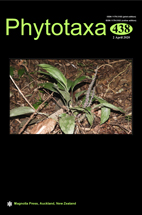Abstract
A new monotypic genus, Mixtecalia, from the Tlaxiaco district located in the state of Oaxaca, Mexico, is described and illustrated. It differs from other Mexican genera of the subtribe Tussilagininae in the monocarpic reproductive strategy (being the only genus of the subtribe to date to have it) as well as the verticillate leaves, the arrangement of which resembles aerial rosettes similar to those of Dendrosenecio. However, in Mixtecalia the verticillate leaves are absent during the flowering period. Mixtecalia has terete and lanate stems; ovate-elliptical leaves, which are tomentose on both surfaces; and paniculiform and bracteate synflorescences, which can reach twice the size of the plant during reproduction. The heads are discoid, with turbinate involucres and 6–8 oblong-lanceolate and lanate phyllaries; each capitulum contains 10–12 yellow florets, with papillose lobes on the apex; the cypselae are cylindrical, 5–6 ribbed and sericeous. The new genus occurs in xerophytic scrub with gypsiferous soils and is known from an area of approximately 1.75 km2, where it coexists with Agave gypsicola and Cephalocereus parvispinus, which dominate the landscape of the type locality.

